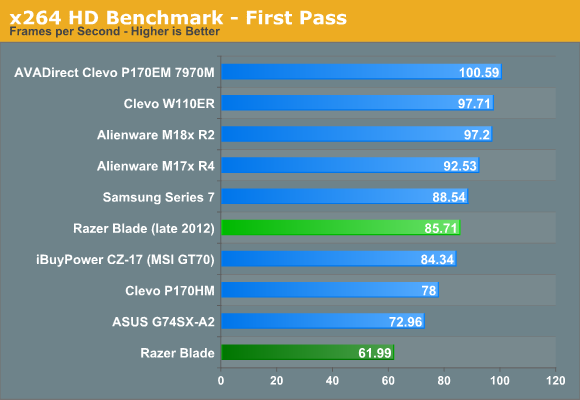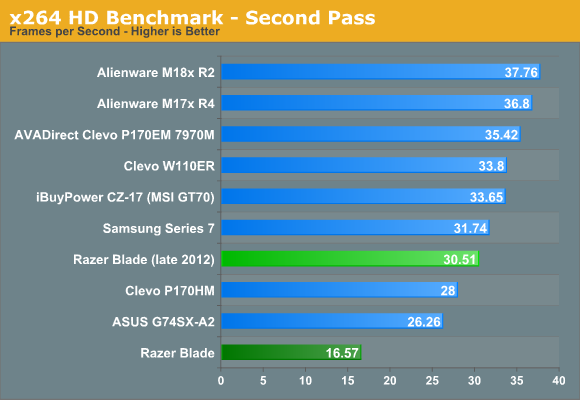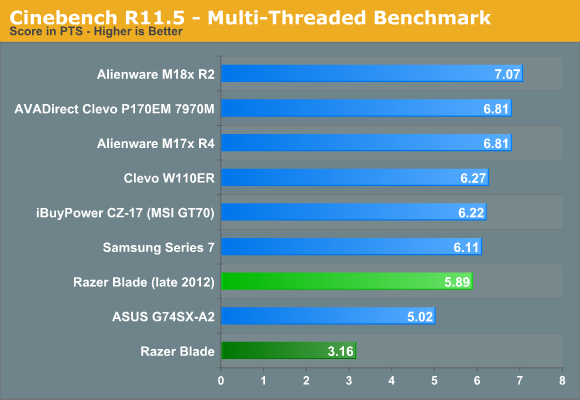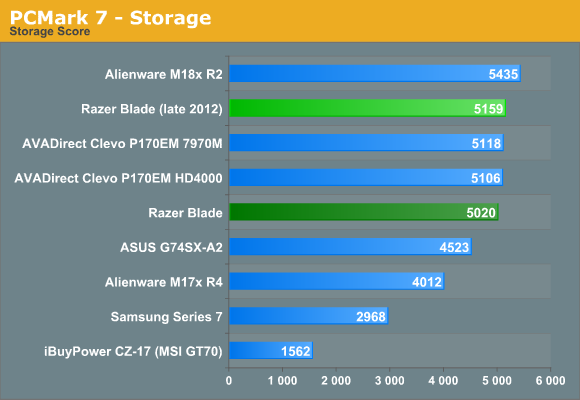The New Razer Blade: Thoroughly Reviewed
by Vivek Gowri on October 3, 2012 5:40 PM ESTRazer Blade (late 2012) - Performance
To gauge how the new Blade stacks up versus its predecessor and other gaming-class notebooks, we picked a decent selection of systems with the entire range of modern GPUs, from the GT 650M GDDR5 in Samsung's Series 7 to the pair of Alienware systems with GTX 680M and 680M SLI graphics configurations. There's a decent range of storage technologies on display here as well, with a number of different SSDs and hybrid storage solutions, along with one conventional 7200RPM hard drive.
| Notebook Configuration Overview | ||||
| CPU | Graphics | Storage | Battery | |
| Alienware M17x R4 | i7-3720QM | GTX 680M | Hybrid (Intel SRT) | 90Wh |
| Alienware M18x R2 | i7-3820QM | GTX 680M SLI | 2x SSD 830 (RAID) | 97Wh |
| ASUS G74SX-A2 | i7-2630QM | GTX 560M | Intel 320 SSD | 90Wh |
| AVADirect Clevo P170EM | i7-3720QM | HD 7970M | Crucial M4 SSD | 77Wh |
| Clevo W110ER | i7-3720QM | GT 650M | Hybrid (Momentus XT) | 62Wh |
| iBUYPOWER MSI GT70 | i7-3610QM | GTX 675M | 7200RPM HDD | 60Wh |
| Razer Blade | i7-2640M | GT 555M | Lite-On M2S SSD | 60Wh |
| Samsung Series 7 | i7-3615QM | GT 650M | Hybrid (ExpressCache) | 77Wh |
| Razer Blade (late 2012) | i7-3632QM | GTX 660M | Hybrid (DataPlex) | 60Wh |
The Blade is the first 35W quad that I’ve dealt with, and it’s the only 35W quad to go through our labs since Dell’s XPS 15 a few months ago. The Blade uses a new OEM-specific i7-3632QM that is essentially the same as the i7-3612QM in the Dell, except with 100MHz faster clocks. Performance-wise, it falls in roughly where you’d expect a 2.2GHz Ivy Bridge quad, a bit faster than the SNB quads and the 2.1GHz i7-3612QM but a bit slower than the various IVB quads that are clocked faster, starting with the 2.3GHz i7-3610 and 3615QM. I'm going to skip straight to the CPU testing this time, as I find PCMark 7 to be far too heavily skewed by other factors (SSD, Quick Sync, etc.)




There’s not too much else to say about Ivy Bridge here; it’s just a really solid CPU that’s done well for Intel. The only complaint that really can be leveled against it is that even though the tick+ update focused heavily on a new on-die graphics architecture, Intel is still playing catch up to AMD’s far more advanced integrated graphics solutions. Intel’s HD 4000 is solid enough for anything not involving gaming though, and in these applications at least, it does its job well.
Traditionally, I try to avoid all Futuremark tests, but I decided to break my rule here with the PCMark 7 storage benchmark. I wanted to see how effective NVELO’s DataPlex caching solution was with respect to Intel’s Smart Response Technology as well as the SSD in the previous Blade. The PCMark Storage score is pretty impressive, beating the SRT-enabled Dell XPS 15 (which had a 32GB cache drive) and interestingly, the old Blade as well. Admittedly, the original Blade’s SSD wasn’t the fastest in the world, even though it used the same Marvell controller as the caching SSD in the new Blade (and the Intel SSD 510, amongst other notable SSDs). We saw better Storage benchmark scores out of faster SSDs in the ASUS N56VM, which was tested using a SandForce-based drive, and Alienware M18x R2 (two Samsung SSD 830s in RAID).

It was a pretty impressive showing, and I actually wasn’t put off by the hard drive too much in day to day usage. The one place where I missed the SSD? Shut down/restart and sleep/wake cycles. I timed a cold boot at 20.8 seconds, a solid 5 seconds off the pace of the old SSDified Blade, and it was definitely something you were reminded of every time the system was rebooted or woken from sleep. As much as the new caching solutions help, nothing can touch the outright responsiveness of a real SSD.










59 Comments
View All Comments
ahamling27 - Wednesday, October 3, 2012 - link
It was my black Macbook from 2007, only larger and with a weird placement of the trackpad. It's sleek, I'll give them that, but I'd much rather pay for something that's bulky but has more horsepower under the hood. That's all we're really talking about here though, and I'm not willing to choose form over function, not at that price point.danjw - Wednesday, October 3, 2012 - link
Ok, so why bother with a comment? To me it is a good trade off of form factor and functionality. Like Vivek, I would prefer an option for a pure SSD; But it isn't a bad compromise they have gone with.I like the Switchblade to play with as well. Some may find it cumbersome to program, but as a computer programmer, I doubt I will find it so.
Anyway mobile devices are about trade offs, some will fit some peoples styles and others will fit others. it is part of the game.
ahamling27 - Wednesday, October 3, 2012 - link
The point was to start a discussion. I honestly don't see why anyone would pay so much for something when a better spec'd machine can be had for quite a bit less. I understand that it's not easy to cram all that in a rather slim and attractive design, but why should that cost such a premium?Back in 2009 I purchased a Gateway P-7811 FX for 40% of the asking price and it's got a 1920x1200 screen, a 9800m gts, and a dual core 2.26 ghz processor, and that was over 3 years ago! Sure it wasn't .88" thin, and all black, but it wasn't ugly either.
All I'm saying is that for this to be anything but an expensive gimmick, they need to figure out a way to lower their costs.
gelb - Wednesday, October 3, 2012 - link
Well in my opinion, its like this; A Toyota Tacoma cost around 30,000 dollars for a 3.4 liter v6 engine and and a great sleek good looking finish along with a nice attention to detail. Now on the other hand is the around 20,000 dollar Nissan Frontier with a 4.0 liter v6 engine. Now, the Tacoma will give you a lot more features along with nicer finish and machine work to the actual frame and parts, but it lacks the "uumph" the Frontier has with it's 4.0 liter v6 engine. Now another thing that should be taken into account their fuel efficiency. The Tacoma gets a much better fuel efficiency than the Frontier does. So, the Blade in my opinion is the Tacoma and the other brands such as Asus etc. are the Frontier makers. In the Blade, you don't get the same kind of power but you trade it for a better finish/build and sleekness.elhoboloco - Thursday, October 4, 2012 - link
> Toyota> Great design
Pick one.
VivekGowri - Thursday, October 4, 2012 - link
Hahaha. You can make the same argument with the 911 and the Corvette, if that helps. Power and value versus refinement, style, fit and finish, design/build quality, etc.Bob Todd - Thursday, October 4, 2012 - link
Saying the Gateway P-7811 FX wasn't ugly doesn't help your case. It was hideous. I had one for 2 days before returning it for a screen defect. Some people are willing to pay (significantly) more for better materials and build quality. You can get the same CPU/GPU/resolution in a $999 Lenovo Y580. That doesn't make it a better laptop for everyone. One feels premium, the other feels like a tin can. It might not be worth it to you, but not everyone has the same use case and priorities as you. You don't try to build a premium brand (with premium margins) by starting off competing in the hotly contested space between $800-$15000. For me, Vivek was spot on about wanting to ditch caching storage and add IPS at this price point. So while I wouldn't spend $2500 on this, I can absolutely understand others doing so. I'd love to have one, and that's kind of the point from a product perspective.Bob Todd - Thursday, October 4, 2012 - link
If only I could edit...that was supposed to be "basically the same CPU/GPU/resolution", as the Blade obviously has the 3632QM vs. the 3610QM in the Y580.ahamling27 - Thursday, October 4, 2012 - link
The Gateway was far from ugly, but what it looks like is purely subjective and had nothing to do with the point I was trying to make. You actually helped me prove my point with the Lenovo. That's a great laptop there, so why does the Switchblade cost $1500 more?$1500 more for something that "feels premium"? It's a plastic body...
The problem with them making a "premium" product is that they aren't using "premium" parts. They are using middle of the road hardware and calling it "premium". That's what I have a problem with.
ahamling27 - Thursday, October 4, 2012 - link
Whoops, now I'm red in the face, I guess it is made of aluminium , not plastic. +1 Razer, but I'm still standing my point, it woefully overpriced.